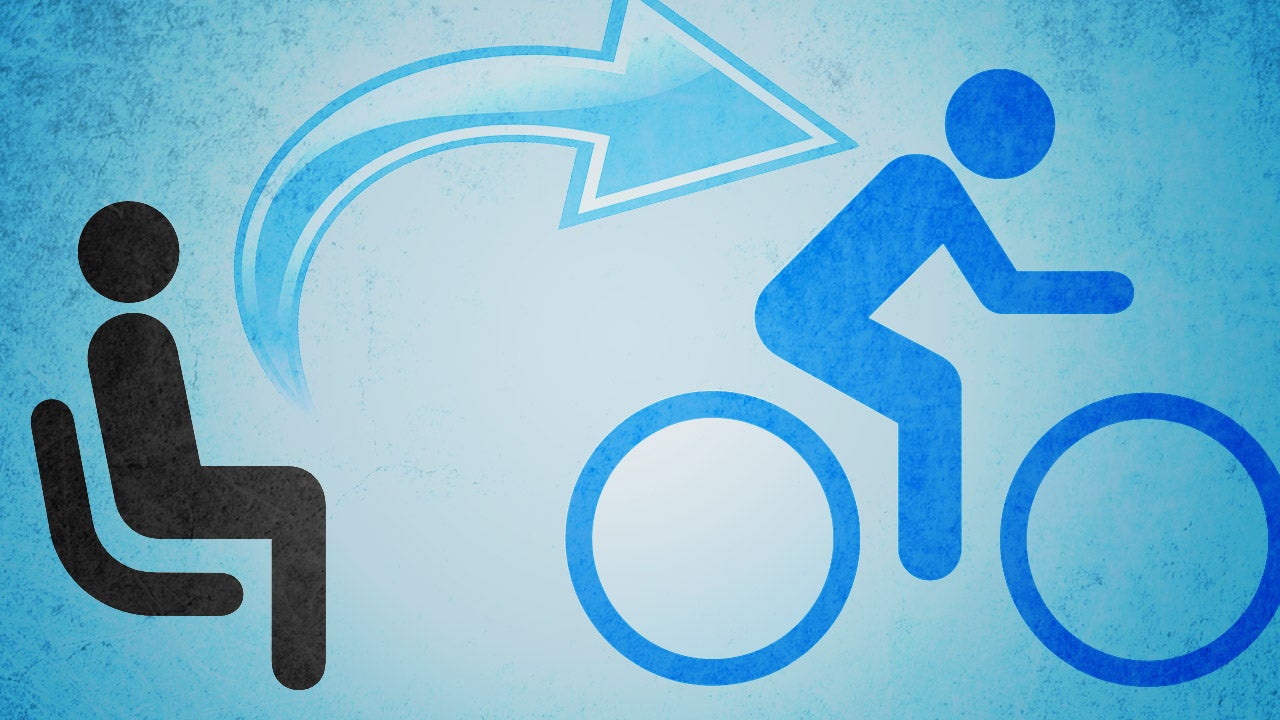
You know her: She eats an ice cream cone like no big deal. And you know she doesn’t always order salad. But she doesn’t have superwoman genes. So how come she doesn’t have to go on a diet? “Diets don’t work. They fail all the time,” says Carla Heiser, a registered dietitian and board-certified specialist in nutritional and metabolic medicine in Chicago. Here are the 10 rules your diet-eschewing pals live by—without having to think about them.
1. Every day isn’t a special occasion. Office doughnuts, a decadent restaurant meal, cake at a friend’s birthday party. These events happen so regularly that it’s easy to justify any day as splurge-worthy. While occasional treats are must-haves, your diet as a whole is what keeps your weight steady, says Heiser. So choose your treats wisely and cut out the rest. Maybe split a crème brûlée with your husband on date night, but pass on the cookies at the meeting during the day. Or celebrate your birthday with cake, but not everyone’s.

2. Talk—a lot—over dinner. Yes, you’re at the table to eat, but you’re also there to catch up with your fellow diners, so make them the star of the show. The gabfest can slow you down so you naturally eat less. In one study in The Journal of Clinical Endocrinology & Metabolism, researchers asked people to consume a bowl of ice cream in five or 30 minutes. Those who enjoyed it slowly excreted more of the “stop eating” gut hormone called peptide YY and reported feeling fuller. So relish the lasagna, but love the company more.
3. Don’t waste time on diet foods. Foods with low-fat or low-calorie labels sound good in theory. The problem is that these are often heavily processed and high in carbs. “These will convert to sugar in your body, potentially contributing to weight gain,” says Heiser. What’s more, companies enhance these products after removing fat by pumping them with sugar, salt and other additives. “Women who don’t diet are still reading ingredient labels,” says Lori Shemek, PhD, author of the forthcoming book fight FATflammation. But they do that to cut through the tricky health claims splashed across the front of the package to find out what’s really in the food.

4. No food is “bad.” It doesn’t pay to refer to brownies as “bad” and kale as “good.” In a University of Toronto study, women who were deprived of chocolate for a week experienced more cravings and were more likely to eat more chocolate. A later 2010 study confirmed the results: If you tell yourself you can’t have chocolate and try not to think about chocolate, you obsess over…chocolate. And find yourself scarfing Snickers. It ties back to thinking you’re a dieting failure, which makes you feel guilty and overeat as a result. For a happier relationship with food, ditch “bad” from your vocabulary.
5. Get your beauty rest. When you’re busy, the first thing that takes a hit is sleep. But if you want to maintain a healthy BMI, research is showing that sleep takes top priority. In fact, on days when you’re sleep deprived and you have to choose between an extra hour of shuteye or waking up early to work out, Dr. Shemek suggests snoozing. “Lack of sleep has hormonal effects that create weight gain and alter your appetite to prefer high-calorie foods. Besides, you won’t have the energy to exercise effectively,” she says.

6. Let yourself off the hook. You’ve just eaten a cheeseburger and polished off the fries. Even if it wasn’t reflective of your healthy eating goals, forgive yourself and move on, promising to eat better at the next meal. Self-compassion can lead to a better relationship with food and a healthier BMI, reveals new research from the University of Waterloo in Canada. Lower self-esteem may lead to disordered eating (like bingeing) that cause weight gain. “Treat yourself like you treat a loved one: with encouragement and affirmation,” says Dr. Shemek.
7. Avoid diet soda. Artificial sweeteners are controversial. While some studies show that they don’t affect weight, other research suggests that calorie-free drinks may cause weight gain by stimulating hunger. Dr. Shemek advises avoiding them completely. “Diet sodas set the brain up for wanting more sugar, and many people get addicted to them,” she says. Plus, ordering a diet soda can make you think you’re saving calories there, so you might as well get the mac and cheese instead of a salad.
8. Experiment in the kitchen. Healthy eating is never boring if you’re jazzing up your meals with herbs and spices. They amplify any dish’s flavor and replace fat while still being just as satisfying, says research from the University of Colorado in Denver. And adding spices like red pepper flakes and cayenne has been shown to boost metabolism, helping you burn a few extra calories from your meal. So add a dash of smoked paprika in place of butter on steamed broccoli. Rather than plain roasted chicken breast, sprinkle on a variety of dried herbs, garlic powder and chili flakes. Bon appetite!

9. Don’t count calories. There’s a huge difference between how your body uses 1,000 calories of junk food and 1,000 calories of whole foods, says Heiser. Getting wrapped up in calorie counts could make you deny yourself calorie-dense, yet nutritious, foods like fatty fish, avocado, oils like olive and coconut, nuts and dark chocolate. Focus on filling your plate with real foods with an emphasis on protein (fish, chicken, tofu), vegetables and a source of healthy fat. Well-rounded meals coupled with heeding your hunger cues can keep you at a healthy weight, she says.

10. Eat sugar smartly. Sugar is simply not good for you. “Your body can only handle so much at one time. If you overdo it, you store it as fat,” says Heiser. But that doesn’t mean you should cut it out completely. “Figure out what your body can handle,” she says. Do you feel tired and bloated after a few cookies? Based on your reaction, you’ll know if you should cut back. After all, food is supposed to make you feel great—and any woman who doesn’t diet knows that.
Source:womansday.com
http://www.healthdigezt.com/10-stay-skinny-secrets-of-women-who-never-diet/
1. Every day isn’t a special occasion. Office doughnuts, a decadent restaurant meal, cake at a friend’s birthday party. These events happen so regularly that it’s easy to justify any day as splurge-worthy. While occasional treats are must-haves, your diet as a whole is what keeps your weight steady, says Heiser. So choose your treats wisely and cut out the rest. Maybe split a crème brûlée with your husband on date night, but pass on the cookies at the meeting during the day. Or celebrate your birthday with cake, but not everyone’s.

2. Talk—a lot—over dinner. Yes, you’re at the table to eat, but you’re also there to catch up with your fellow diners, so make them the star of the show. The gabfest can slow you down so you naturally eat less. In one study in The Journal of Clinical Endocrinology & Metabolism, researchers asked people to consume a bowl of ice cream in five or 30 minutes. Those who enjoyed it slowly excreted more of the “stop eating” gut hormone called peptide YY and reported feeling fuller. So relish the lasagna, but love the company more.
3. Don’t waste time on diet foods. Foods with low-fat or low-calorie labels sound good in theory. The problem is that these are often heavily processed and high in carbs. “These will convert to sugar in your body, potentially contributing to weight gain,” says Heiser. What’s more, companies enhance these products after removing fat by pumping them with sugar, salt and other additives. “Women who don’t diet are still reading ingredient labels,” says Lori Shemek, PhD, author of the forthcoming book fight FATflammation. But they do that to cut through the tricky health claims splashed across the front of the package to find out what’s really in the food.

4. No food is “bad.” It doesn’t pay to refer to brownies as “bad” and kale as “good.” In a University of Toronto study, women who were deprived of chocolate for a week experienced more cravings and were more likely to eat more chocolate. A later 2010 study confirmed the results: If you tell yourself you can’t have chocolate and try not to think about chocolate, you obsess over…chocolate. And find yourself scarfing Snickers. It ties back to thinking you’re a dieting failure, which makes you feel guilty and overeat as a result. For a happier relationship with food, ditch “bad” from your vocabulary.
5. Get your beauty rest. When you’re busy, the first thing that takes a hit is sleep. But if you want to maintain a healthy BMI, research is showing that sleep takes top priority. In fact, on days when you’re sleep deprived and you have to choose between an extra hour of shuteye or waking up early to work out, Dr. Shemek suggests snoozing. “Lack of sleep has hormonal effects that create weight gain and alter your appetite to prefer high-calorie foods. Besides, you won’t have the energy to exercise effectively,” she says.

6. Let yourself off the hook. You’ve just eaten a cheeseburger and polished off the fries. Even if it wasn’t reflective of your healthy eating goals, forgive yourself and move on, promising to eat better at the next meal. Self-compassion can lead to a better relationship with food and a healthier BMI, reveals new research from the University of Waterloo in Canada. Lower self-esteem may lead to disordered eating (like bingeing) that cause weight gain. “Treat yourself like you treat a loved one: with encouragement and affirmation,” says Dr. Shemek.
7. Avoid diet soda. Artificial sweeteners are controversial. While some studies show that they don’t affect weight, other research suggests that calorie-free drinks may cause weight gain by stimulating hunger. Dr. Shemek advises avoiding them completely. “Diet sodas set the brain up for wanting more sugar, and many people get addicted to them,” she says. Plus, ordering a diet soda can make you think you’re saving calories there, so you might as well get the mac and cheese instead of a salad.
8. Experiment in the kitchen. Healthy eating is never boring if you’re jazzing up your meals with herbs and spices. They amplify any dish’s flavor and replace fat while still being just as satisfying, says research from the University of Colorado in Denver. And adding spices like red pepper flakes and cayenne has been shown to boost metabolism, helping you burn a few extra calories from your meal. So add a dash of smoked paprika in place of butter on steamed broccoli. Rather than plain roasted chicken breast, sprinkle on a variety of dried herbs, garlic powder and chili flakes. Bon appetite!

9. Don’t count calories. There’s a huge difference between how your body uses 1,000 calories of junk food and 1,000 calories of whole foods, says Heiser. Getting wrapped up in calorie counts could make you deny yourself calorie-dense, yet nutritious, foods like fatty fish, avocado, oils like olive and coconut, nuts and dark chocolate. Focus on filling your plate with real foods with an emphasis on protein (fish, chicken, tofu), vegetables and a source of healthy fat. Well-rounded meals coupled with heeding your hunger cues can keep you at a healthy weight, she says.

10. Eat sugar smartly. Sugar is simply not good for you. “Your body can only handle so much at one time. If you overdo it, you store it as fat,” says Heiser. But that doesn’t mean you should cut it out completely. “Figure out what your body can handle,” she says. Do you feel tired and bloated after a few cookies? Based on your reaction, you’ll know if you should cut back. After all, food is supposed to make you feel great—and any woman who doesn’t diet knows that.
Source:womansday.com
http://www.healthdigezt.com/10-stay-skinny-secrets-of-women-who-never-diet/


























